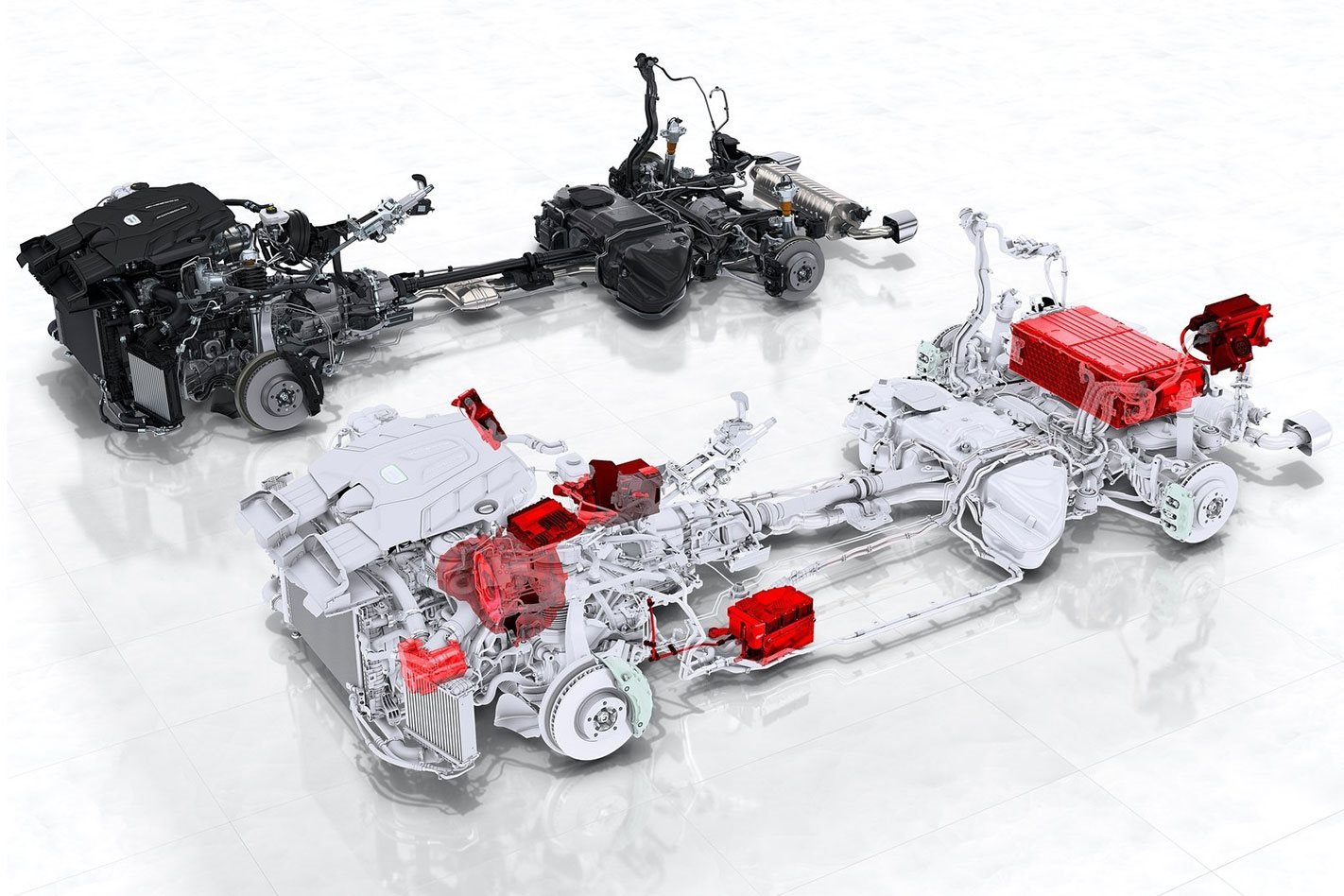
Until a plethora of Hollywood actors had their pictures snapped at the wheel of a Toyota Prius, the term ‘hybrid vehicle’ was largely unknown in the automotive world. And it’s fair to say that the most exciting thing about those earliest hybrids was their celebrity owners, but times have changed.
The original Prius was a so-called ‘mild hybrid’ which means the only way it could charge its on-board battery was with a petrol engine, but the hot news in electrified drivetrains is the ‘plug-in hybrid electric vehicle’ or PHEV. With a charging socket plug-ins offer a limited pure-electric range, bridging the void between traditional hybrids and fully electric vehicles and allowing drivers to do shorter trips entirely on cheap electricity.
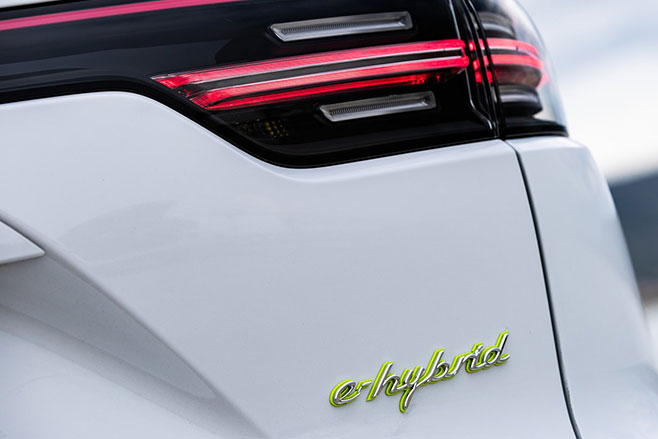
Plug-in hybrids are not new to high-performance purveyor Porsche, but its latest model – the Cayenne E-Hybrid – arrives with some significant advances in the technological sphere. Here’s everything you need to know about the Cayenne E-Hybrid’s special drivetrain.
Motor-vation
At the heart of the E-Hybrid system, a 100kW electric motor provides the Cayenne with its zero-emissions capability and 400Nm of torque. The motor is located between the 3.0-litre turbocharged V6 petrol (which contributes another 250kW and 450Nm when required) and an eight-speed automatic transmission.
Unlike separated electric motors such as axle-mounted and hub motors, its positioning allows power to be sent to all four wheels exactly as the V6 does. The result is a relatively uncomplicated and compact transmission that provides consistent performance and requires no adjustment in driving style when the drive mode is switched.
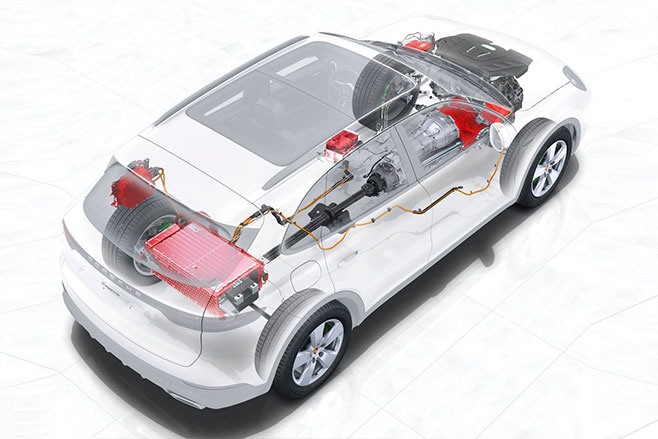
The same motor also acts as a generator. Press the brake pedal lightly and instead of the massive ten-piston callipers slowing the car, regenerative braking scrubs speed while recharging the battery with the Cayenne’s kinetic energy. This is where a large part of the E-Hybrid’s energy efficiency comes from.
In a conventional car, the brakes generate heat which is lost to the surrounding air but the Cayenne’s system recaptures what would otherwise be waste. Under heavier braking the traditional brake discs and callipers take over.
Charged with battery
Feeding the sophisticated motor is a 14.1kWh battery hidden under the Cayenne’s boot floor. Compared with the previous-generation hybrid Cayenne, the pack has gained 30 percent more capacity – enough to propel the large SUV up to 44km without using a single drop of petrol.
Topping up that battery is as simple as plugging in any other home appliance. With a standard 240-volt socket, the Cayenne’s battery can be filled in a matter of hours – four hours from a 16-amp power socket and about eight for a standard 8.0-amp outlet, but that can be shaved down to a little over two hours with high-rate chargers.
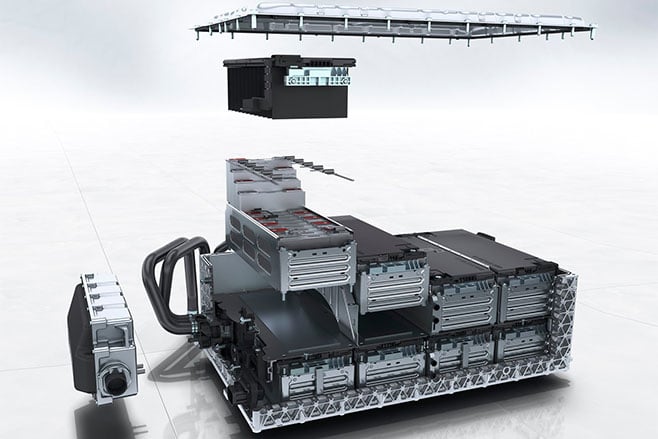
Pumping water around a complex high-voltage battery might seem like a bad idea, but the E-Hybrid battery cooling system allows the lithium ion pack to operate more efficiently and in a broader range of conditions.
In cooler conditions or if the battery has remained inactive for some time, the system can warm (or precondition) the battery allowing it to deliver close to its full potential from start. Owners can even set a timer allowing the vehicle to start the process before the vehicle is driven away.
During hotter weather or when working hard, excess heat generated by the battery can be controlled by the same liquid cooling system.
As you might expect, the electrical system components add extra weight and the battery robs some space from the boot area but the advantages are clear. Compared with the entry-level Cayenne – which uses the same engine minus the hybridisation – the E-Hybrid is 310kg heavier and sacrifices 125 litres of luggage volume, but accelerates from zero to 100km nearly a second faster and uses about a third of the fuel on the combined cycle (9.2L/100km vs 3.4L/100km). More to the point, if a majority of your journeys are less than 44km, it needn’t use any fuel at all.
Mode swings
Option any Porsche with the Sport Chrono package and you’ll get a handy driving mode selector dial mounted on the steering wheel. However, the Cayenne E-Hybrid is equipped with the feature as standard allowing swift access to the various drivetrain modes. Flipping between electric, hybrid and full-power sport modes is as easy as twisting that dial.
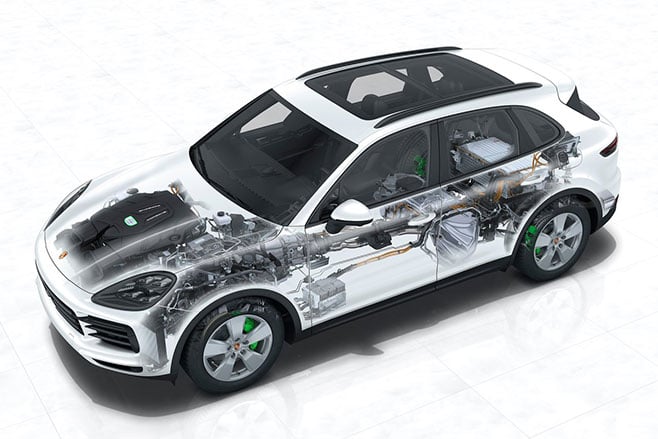
E-Power
In its default mode the Cayenne is a pure electric vehicle capable of travelling up to 44km on the energy stored in the battery and at speeds of up to 135km/h before the petrol engine is required. Even though E-power is selected, the driver can fire up the engine for full acceleration by pressing the accelerator through a pressure point when overtaking, for example.
Hybrid
Full electric power makes most sense and is most efficient when negotiating low speeds and stop-start traffic – where drag is minimal and the benefits of regenerative braking are greatest – but for all other driving, Hybrid Auto mode makes the best use of electrical power and the V6 engine.
As soon as the vehicle is being driven at higher constant speeds, the petrol engine fires up preserving charge, but if the driving conditions change later in the journey such as slow traffic, electric power is reinstated. The system can sense gradient changes and, if a destination is entered into the navigation, it will plan its power use accordingly.
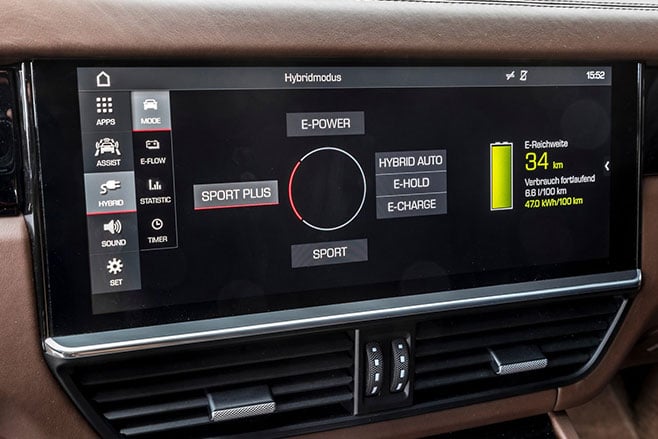
Alternatively the driver can manually select an E-Hold mode in the hybrid settings which will avoid using battery power, thereby conserving charge for pure EV or hybrid driving for later in the journey. An E-Charge mode engages the petrol engine for longer and shifts the load point to focus on charging the battery.
Sport and Sport Plus
When Sport mode is selected, the V6 engine runs continuously ready to provide combustion power as soon as it is needed, while also charging the battery to the minimum required for electrical boosting of power and acceleration. With Sport Plus engaged, the charging system tops up the battery to maximum, allowing the highest boost availability during the most enthusiastic driving.
Green guide
Unlike a simple fuel gauge, there’s a little more involved with keeping an eye on a hybrid powertrain, but the Cayenne’s instrument cluster has been tailored specifically for the E-Hybrid.As a rule, if it’s a cool zombie-apocalypse Acid Green, it’s hybrid related.
Below the central tachometer (complete with green needle) a simple power gauge indicates the flow of electrical power. Accelerate hard and the full row of green LEDs lining the left of the tacho will blink on and the display is reversed under regenerative braking. The harder you brake or accelerate the more lights that illuminate.
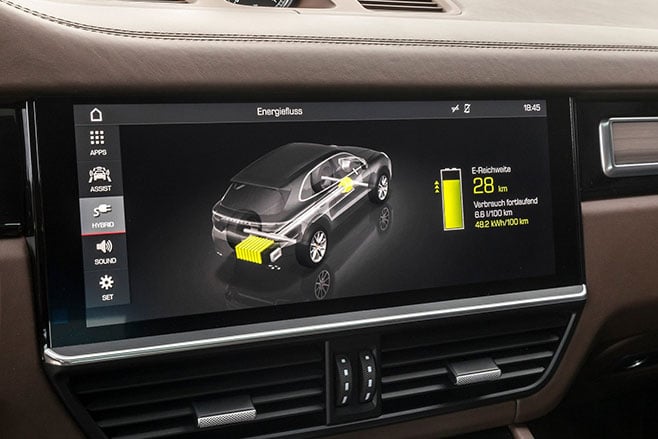
To the left of the central gauge, a fully digital display which houses the speedometer also has a predictive range gauge. Unlike the more basic battery gauge situated under the fuel level, the ‘hybrid assistant’ calculates the range remaining in the battery according to environmental conditions and driving style. Point your toe a little further and the E-Max portion illuminates to indicate that petrol power has been called upon.
In the opposite digital display, the driver can select an energy flow screen which uses animations to explain when the engine and motor are contributing and their corresponding energy paths. Roll the steering-wheel-mounted selector down another screen and the E-consumption gauge is displayed. Like a fuel consumption gauge this screen tells the driver how many kilowatt hours (kWh) are being used – the electric car equivalent of litres per 100km. Flick on the electrically-driven air conditioning or put your foot down and the gauge will tell you what effect that is having on your economy.
Quiet achiever
Of course, all of this electric technology makes for a very low-noise Cayenne, and if you are craving a more typical Porsche soundtrack, the third generation introduces one more feature for the hybrid. Tick the box for the optional sports exhaust system and every time that turbo V6 cranks into life there will be no mistaking what’s under the bonnet.




